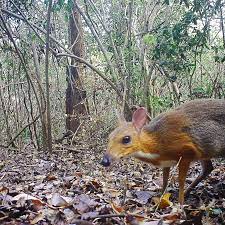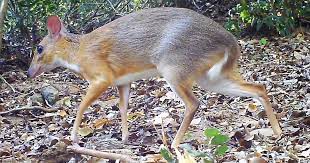Tragulus, often referred to as “mouse-deer,” is a remarkable and enigmatic creature found in the forests of Southeast Asia. Despite its small size and elusive nature, Tragulus has captivated the imagination of wildlife enthusiasts and scientists alike. In this article, we’ll delve into 60 intriguing facts about this unique animal, shedding light on its habits, characteristics, and significance in the natural world.

- Tiny Stature: Tragulus is one of the smallest hoofed mammals in the world, measuring just about 40-75 centimeters in length.
- Taxonomic Puzzle: Tragulus belongs to the family Tragulidae, which includes several species, making it a taxonomic challenge.
- Habitat Diversity: They inhabit various ecosystems, from dense rainforests to swamps and grasslands.
- Fruit Lovers: Their diet primarily consists of fruits, leaves, and shoots.
- Solitary Creatures: Tragulus are solitary animals, seldom seen in groups.
- Nocturnal Lifestyle: They are primarily active during the night, venturing out in search of food under the cover of darkness.
- Cryptic Coloration: Their fur, often a reddish-brown color, helps them blend into their forested environments.
- Territorial Behavior: Tragulus mark their territory with secretions from scent glands located on their feet.
- High-Pitched Calls: They communicate using high-pitched vocalizations, which are difficult for humans to detect.
- Ancient Lineage: Tragulus represents one of the most primitive lineages of ruminants, dating back millions of years.
- Dwarfed Hooves: These creatures have tiny hooves, resembling those of a deer’s fawn.
- Elusive Sightings: Due to their elusive nature, Tragulus sightings in the wild are rare.
- Conservation Concerns: Some species of Tragulus are threatened by habitat loss and hunting.
- Slow Reproduction: They have a low reproductive rate, with only one offspring born at a time.
- Distinctive Canines: Male Tragulus have elongated, tusk-like canines used for territorial disputes.
- Mysterious Behavior: Much of Tragulus’ behavior in the wild remains a mystery to researchers.
- Primarily Herbivores: Despite having canines, they are primarily herbivorous.
- Subtle Sexual Dimorphism: Males and females look very similar, with slight differences in size.
- Endangered Status: Some Tragulus species are listed as endangered due to habitat destruction.
- Nocturnal Eyesight: They have adapted well to low light conditions, thanks to their large eyes.
- Curious Noses: Tragulus have a keen sense of smell, aiding in their search for food.
- Scent-Marking Behavior: They leave scent markings on trees and vegetation to communicate with other Tragulus.
- Shy Creatures: Tragulus is extremely shy around humans, making it challenging to study them in the wild.
- Uncommon Predators: Predators include large snakes and birds of prey.
- Marsupial Connection: Some scientists believe Tragulus shares a common ancestor with marsupials.
- Secretive Nesting: Females hide their young in secluded nests for protection.
- Vulnerable to Disease: Habitat fragmentation puts them at risk of diseases transmitted by other wildlife.
- Matriarchal Society: Females often lead their young through the forest.
- African Cousin: The water chevrotain, a distant relative, is found in Africa.
- Understudied Species: Despite their fascinating traits, Tragulus species are relatively understudied.
- Camouflaging Babies: Newborns have spots and stripes, aiding in camouflage.
- Symbiotic Relationships: They play a role in dispersing seeds, benefiting the ecosystem.
- Insectivorous Tendencies: Tragulus sometimes consume insects, providing balance in their diet.
- Rare Discoveries: New species of Tragulus are still being discovered in the remote wilderness.
- Microhabitats: They inhabit microhabitats within larger ecosystems, adding to their mystery.
- Climate Adaptation: Tragulus species adapt to different climates, from tropical to temperate.
- Indonesia’s Icon: The lesser mouse-deer is a symbol of Indonesian biodiversity.
- Evolutionary Link: Studying Tragulus offers insights into the early evolution of ruminants.
- Conservation Efforts: Organizations work tirelessly to protect Tragulus’ habitats.
- Adaptable Survivors: They have persisted through environmental changes over millions of years.
- Cryptic Nocturnality: Their nocturnal habits help them avoid diurnal predators.
- Forest Engineers: Tragulus’ feeding habits influence forest composition.
- Intraspecific Aggression: Males can be aggressive when defending territory.
- Evasive Behavior: They often rely on evasive maneuvers to escape predators.
- Sentinel Behavior: Some Tragulus serve as “sentinels” in the forest, alerting others to danger.
- Gestation Period: Pregnancy lasts around five months.
- Tiny Home Ranges: They have small home ranges due to their herbivorous diet.
- Sparse Population Data: Population estimates are challenging due to their elusive nature.
- Subtle Gestures: Tragulus communicate through body language and vocalizations.
- Mystical Folklore: In some cultures, Tragulus is associated with mystical properties.
- Zoological Mysteries: Zoologists continue to unravel the secrets of Tragulus.
- Limited Domestication: Tragulus has not been successfully domesticated.
- Ancient Artifacts: Tragulus imagery appears in ancient art.
- Vulnerable to Predators: Larger mammals pose a significant threat to Tragulus.
- Periscope Behavior: They often raise their heads above tall grasses to survey their surroundings.
- Mysterious Evolutionary Path: The evolutionary history of Tragulus remains puzzling.
- Ecosystem Engineers: They influence plant diversity through seed dispersal.
- Ecological Role: Tragulus is an important part of its ecosystem’s food web.
- Endearing Appearance: Their small size and cute features make them endearing to many.
- Inspirational Conservation: The plight of Tragulus inspires conservation efforts across the globe.
In conclusion, Tragulus, the elusive mouse-deer, is a creature shrouded in mystery and ecological significance. As we continue to unravel its secrets, it serves as a reminder of the diverse and enchanting world of wildlife. Protecting these remarkable animals and their habitats is essential for the preservation of our natural heritage.



















Add Comment